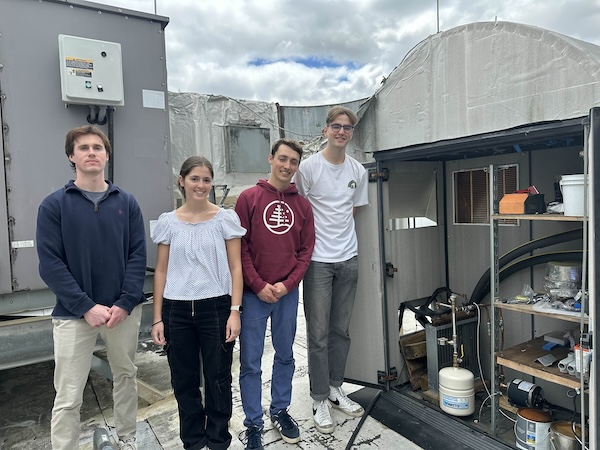Tulane Professor Matthew Escarra and his team of students innovate new solar technology with the "Sunflower Receiver" atop Flower Hall
April 18, 2024
Blooming high atop Tulane University's Donna and Paul Flower Hall— innovation turns into ‘eco-vation’ via a futuristic-looking solar energy conversion system named the “Sunflower Receiver,” which successfully harvests sunlight to generate electricity and heat.
The system starts with a large dish-shaped mirror which is always pointed at the sun using a two-axis tracker. The mirror concentrates sunlight onto a hybrid receiver, which features a dense array of high-efficiency solar cells mounted on top of a black-painted coil. After absorbing the sunlight, this cogeneration device creates electricity and heats water that flows through the receiver. The hot water or steam output has been demonstrated to reach up to 480 F. This novel energy producer has produced a system efficiency as high as 85% compared to 20% from traditional solar panels.
Professor Matthew Escarra originally developed the Sunflower Receiver in collaboration with Professor Daniel Codd at the University of San Diego, building on the technology they jointly developed with a $3.3M Department of Energy ARPA-E grant. Escarra’s team developed the receiver hardware, and Codd’s team tested it in San Diego.
Last year, the project was propelled even further with funding awarded by the Tulane Innovation Institute Provost’s Proof of Concept fund. This award enabled the team to initiate a pilot plant demonstration of the technology in partnership with Bernhard, Tulane’s energy-as-a-service partner. This required moving the testbed from San Diego to New Orleans, installing it on the roof of Flower Hall, and integrating its energy outputs directly into the building for daily use. Escarra, Codd, a team of four senior Engineering Physics majors (Owen Harris, Timothy Keegan, Thalia Koutsougeras, and Axel Nielsen), and Sid Padmanabha, a Materials Engineering PhD student, have been active designing, prototyping, and testing their system with technology upgrades to enable this building-integrated pilot plant, with the assistance of Bernhard.
When asked about the student's experience, Axel Nielsen (Tulane ’24) said, “It’s surprising how many things will inevitably go wrong when designing and building something. So many things can make sense on paper or conceptually, but when you try to build it in the real world, there are many aspects that you have yet to consider that will derail you. It's about adapting to those setbacks, learning from them, and moving on to the next problem. When New Orleans froze in January, our radiator burst, which required me to learn and practice how to solder pipe, something I never saw myself doing, but something I'm happy to know about now.”
Thalia Koutsougeras (Tulane ’24), who will work as an Automated Test Systems Engineer at Boeing following graduation, said: “This project helped reaffirm my interest in the research and development area. It has been amazing to see our ideas become fully realized into a functioning system after much designing and modeling.”
In addition to Boeing, Lockheed Martin Space recognized top talent on this team. Owen Harris (Tulane ’24), was recruited to work with their laser technology development this summer. Harris said “Fabricating and packaging this device has been like a puzzle, with each step of the process a piece I need to fit together. I’ve enjoyed this kind of problem-solving, and it’s drawn me to work in the semiconductor industry working on similar kinds of puzzles.”
In addition to funding, the Tulane Innovation Institute is committed to helping Escarra find industry partners for this technology. "We have identified potential customers primed to be early adopters of our technology," Escarra stated. "With data from this pilot plant, we are well-positioned to refine our technology roadmap and pursue further scale-up opportunities."
“This is exactly the type of project that the Provost’s Proof of Concept Fund is meant to help support,” said Clay Christian, Executive Director for Commercialization at the Institute. “We are thrilled to be able to support innovative faculty and student projects like Dr. Escarra in partnership with the Provost, moving Tulane technologies and ideas into the market to create real impact.”
The typical customer for this project is a company that currently uses process heat (steam or hot water) generated in natural gas boilers to fulfill its energy needs. Examples include food processing companies, beer brewers, and chemical refiners. These customers could use this renewable alternative to reduce their carbon footprint and energy costs.
In addition, hospitals and universities could use this solar cogeneration technology to reduce central plant steam dependency and help create zero-net energy buildings.
As the world races to find new energy sources, while training the next generation of scientists and engineers, “this project exemplifies Tulane University's commitment to innovation and sustainability while underscoring the significance of how student involvement can drive real-world impact," Escarra emphasized.
Timothy Keegan (Tulane ’24) stated, “In the classroom, we often focus on complex problems associated with engineering concepts; however, this experience helped us learn about problems that can arise when physically implementing the technologies we design.”
In the next one to two years, Escarra envisions significant strides for the project "Our goal is to continue developing our solar receiver technology towards higher performance and durability…ultimately transitioning towards commercialization with external partners."

